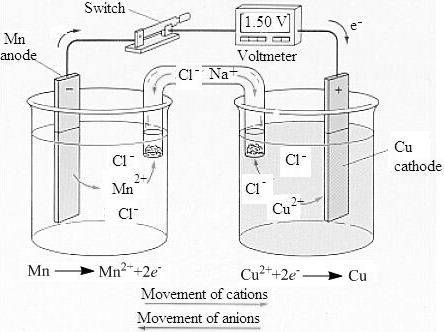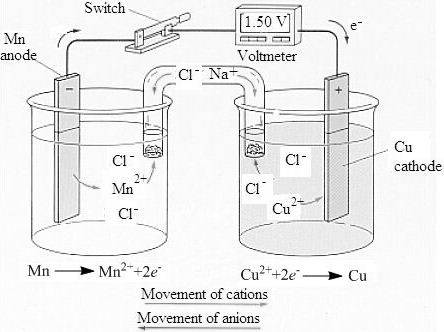
Concept explainers
(a)
To determine: Sketch of a labeled voltaic cell and the concentration of the solution.
(a)
Answer to Problem 1DE
The labeled sketch of the voltaic cell is,

The concentration of the copper and the manganese ion is
Explanation of Solution
Given
The electrical potential output of the cell is
The external device draws the current of
The electric potential of the cell is calculated as,
According to the above equation, the difference in the oxidation and the reduction potential should be
The standard oxidation potential of manganese is
Therefore, the pair of manganese and copper is used to construct a voltaic cell with manganese being anode at which oxidation takes place and copper being cathode at which reduction takes place.
The standard reduction potential is the potential of the electrode dipped in the aqueous solution of its ion of concentration
Therefore, the concentration of the copper and the manganese ion is
We are given the beaker of the capacity of
The volume of the solution of manganese and copper ion is assumed to be
The labeled sketch of the voltaic cell is,

- Figure. 1
The mass of the manganese in the
Substitute the value of molar concentration, molar mass and the volume of the solution of manganese in the above equation.
The mass of the copper in the
Substitute the value of molar concentration, molar mass and the volume of the solution of copper in the above equation.
Therefore, the mass of manganese and copper present in the
The concentration of the copper and the manganese ion is
(b)
To determine: The concentration of manganese and copper ion in the solution after
(b)
Answer to Problem 1DE
Explanation of Solution
Given
The electrical potential output of the cell is
The external device draws the current of
The charge transport is calculated by the formula,
Substitute the value of current and time in the above formula,
Charge on each electron is
The moles of electron present in
Substitute the value of charge transfer, charge on each electron and Avogadro’s number in the above formula.
Two electron transfer takes place by oxidation and reduction of manganese and copper, respectively.
Therefore, the change in moles of manganese and copper is:
The initial concentration of the ions is
Thus, one mole of ion is present in one liter of the solution and
The number of moles of manganese ion increase due to oxidation of metal. Therefore, the molar concentration of manganese ion in
The number of moles of copper ion increase due to oxidation of metal. Therefore, the molar concentration of copper ion in
Thus, the concentration of manganese and copper ion after two hours is
The concentration of manganese and copper ion after two hours is
(c)
To determine: The voltage that a cell register at the end of the discharge.
(c)
Answer to Problem 1DE
Explanation of Solution
Given
The electrical potential output of the cell is
The external device draws the current of
The concentration of manganese and copper ion after two hours is
The standard oxidation potential of manganese is
The standard reduction potential is the potential of the electrode dipped in the aqueous solution of its ion of concentration
Thus, one mole of manganese ion gives the oxidation potential of
Therefore,
One mole of copper ion gives the reduction potential of
Therefore,
The electric potential of the cell at discharge is calculated as,
Substitute the value of oxidation and reduction potential in the above equation.
Thus, the end cell potential is
The end cell potential is
(d)
To determine: The time taken for the reactant of one cell to get completely consumed.
(d)
Answer to Problem 1DE
Explanation of Solution
Given
The electrical potential output of the cell is
The external device draws the current of
The charge transport is calculated by the formula,
Substitute the value of current and time in the above formula,
Charge on each electron is
The moles of electron present in
Substitute the value of charge transfer, charge on each electron and Avogadro’s number in the above formula.
Two electron transfer takes place by oxidation and reduction of manganese and copper, respectively.
Therefore, the change in moles of manganese and copper is
Charge is directly proportional to time at constant current flow.
The charge transferred is
The total initial concentration of the reactant of one half cell is one molar.
Therefore, the charge transfer of one molar takes place in
The charge transfer of one molar takes place in
Want to see more full solutions like this?
Chapter 20 Solutions
Chemistry: The Central Science (14th Edition)
- What are the angles a and b in the actual molecule of which this is a Lewis structure? H- :0: C=N: b Note for advanced students: give the ideal angles, and don't worry about small differences from the ideal that might be caused by the fact that different electron groups may have slightly different sizes. a = 0° b=0 Xarrow_forwardA student proposes the transformation below in one step of an organic synthesis. There may be one or more products missing from the right-hand side, but there are no reagents missing from the left-hand side. There may also be catalysts, small inorganic reagents, and other important reaction conditions missing from the arrow. • Is the student's transformation possible? If not, check the box under the drawing area. • If the student's transformation is possible, then complete the reaction by adding any missing products to the right-hand side, and adding required catalysts, inorganic reagents, or other important reaction conditions above and below the arrow. • You do not need to balance the reaction, but be sure every important organic reactant or product is shown. + This transformation can't be done in one step. T iarrow_forwardDetermine the structures of the missing organic molecules in the following reaction: H+ O OH H+ + H₂O ☑ ☑ Note: Molecules that share the same letter have the exact same structure. In the drawing area below, draw the skeletal ("line") structure of the missing organic molecule X. Molecule X shows up in multiple steps, but you only have to draw its structure once. Click and drag to start drawing a structure. X § ©arrow_forward
- Table 1.1 Stock Standard Solutions Preparation. The amounts shown should be dissolved in 100 mL. Millipore water. Calculate the corresponding anion concentrations based on the actual weights of the reagents. Anion Amount of reagent (g) Anion Concentration (mg/L) 0.1649 Reagent Chloride NaCl Fluoride NaF 0.2210 Bromide NaBr 0.1288 Nitrate NaNO3 0.1371 Nitrite NaNO2 0.1500 Phosphate KH2PO4 0.1433 Sulfate K2SO4 0.1814arrow_forwardDraw the structure of the pound in the provided CO as a 300-1200 37(2), 11 ( 110, and 2.5 (20arrow_forwardPlease help me with # 4 and 5. Thanks in advance!arrow_forward
- A small artisanal cheesemaker is testing the acidity of their milk before it coagulates. During fermentation, bacteria produce lactic acid (K₁ = 1.4 x 104), a weak acid that helps to curdle the milk and develop flavor. The cheesemaker has measured that the developing mixture contains lactic acid at an initial concentration of 0.025 M. Your task is to calculate the pH of this mixture and determine whether it meets the required acidity for proper cheese development. To achieve the best flavor, texture and reduce/control microbial growth, the pH range needs to be between pH 4.6 and 5.0. Assumptions: Lactic acid is a monoprotic acid H H :0:0: H-C-C H :0: O-H Figure 1: Lewis Structure for Lactic Acid For simplicity, you can use the generic formula HA to represent the acid You can assume lactic acid dissociation is in water as milk is mostly water. Temperature is 25°C 1. Write the K, expression for the dissociation of lactic acid in the space provided. Do not forget to include state symbols.…arrow_forwardCurved arrows are used to illustrate the flow of electrons. Using the provided starting and product structures, draw the curved electron-pushing arrows for the following reaction or mechanistic step(s). Be sure to account for all bond-breaking and bond-making steps. :0: :0 H. 0:0 :0: :6: S: :0: Select to Edit Arrows ::0 Select to Edit Arrows H :0: H :CI: Rotation Select to Edit Arrows H. < :0: :0: :0: S:arrow_forward3:48 PM Fri Apr 4 K Problem 4 of 10 Submit Curved arrows are used to illustrate the flow of electrons. Using the provided starting and product structures, draw the curved electron-pushing arrows for the following reaction or mechanistic step(s). Be sure to account for all bond-breaking and bond-making steps. Mg. :0: Select to Add Arrows :0: :Br: Mg :0: :0: Select to Add Arrows Mg. Br: :0: 0:0- Br -190 H 0:0 Select to Add Arrows Select to Add Arrows neutralizing workup H CH3arrow_forward
- Iarrow_forwardDraw the Markovnikov product of the hydrobromination of this alkene. Note for advanced students: draw only one product, and don't worry about showing any stereochemistry. Drawing dash and wedge bonds has been disabled for this problem. + Explanation Check 1 X E 4 1 1 1 1 1 HBr Click and drag to start drawing a structure. 80 LE #3 @ 2 $4 0 I அ2 % 85 F * K M ? BH 2025 McGraw Hill LLC. All Rights Reserved. Terms of Use Privacy Center & 6 27 FG F10 8 9 R T Y U D F G H P J K L Z X C V B N M Q W A S H option command H command optiarrow_forwardBe sure to use wedge and dash bonds to show the stereochemistry of the products when it's important, for example to distinguish between two different major products. Predict the major products of the following reaction. Explanation Q F1 A Check F2 @ 2 # 3 + X 80 F3 W E S D $ 4 I O H. H₂ 2 R Pt % 05 LL ee F6 F5 T <6 G Click and drag to start drawing a structure. 27 & A 2025 McGraw Hill LLC. All Rights Reserved. Terms of Use Privacy Center Acce Y U H DII 8 9 F10 4 J K L Z X C V B N M T H option command F11 P H commandarrow_forward
 ChemistryChemistryISBN:9781305957404Author:Steven S. Zumdahl, Susan A. Zumdahl, Donald J. DeCostePublisher:Cengage Learning
ChemistryChemistryISBN:9781305957404Author:Steven S. Zumdahl, Susan A. Zumdahl, Donald J. DeCostePublisher:Cengage Learning ChemistryChemistryISBN:9781259911156Author:Raymond Chang Dr., Jason Overby ProfessorPublisher:McGraw-Hill Education
ChemistryChemistryISBN:9781259911156Author:Raymond Chang Dr., Jason Overby ProfessorPublisher:McGraw-Hill Education Principles of Instrumental AnalysisChemistryISBN:9781305577213Author:Douglas A. Skoog, F. James Holler, Stanley R. CrouchPublisher:Cengage Learning
Principles of Instrumental AnalysisChemistryISBN:9781305577213Author:Douglas A. Skoog, F. James Holler, Stanley R. CrouchPublisher:Cengage Learning Organic ChemistryChemistryISBN:9780078021558Author:Janice Gorzynski Smith Dr.Publisher:McGraw-Hill Education
Organic ChemistryChemistryISBN:9780078021558Author:Janice Gorzynski Smith Dr.Publisher:McGraw-Hill Education Chemistry: Principles and ReactionsChemistryISBN:9781305079373Author:William L. Masterton, Cecile N. HurleyPublisher:Cengage Learning
Chemistry: Principles and ReactionsChemistryISBN:9781305079373Author:William L. Masterton, Cecile N. HurleyPublisher:Cengage Learning Elementary Principles of Chemical Processes, Bind...ChemistryISBN:9781118431221Author:Richard M. Felder, Ronald W. Rousseau, Lisa G. BullardPublisher:WILEY
Elementary Principles of Chemical Processes, Bind...ChemistryISBN:9781118431221Author:Richard M. Felder, Ronald W. Rousseau, Lisa G. BullardPublisher:WILEY





